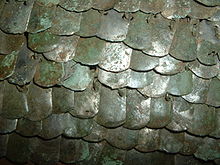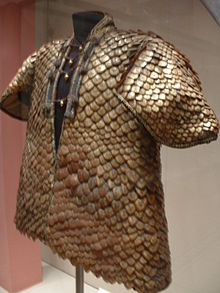Traveling within the World
Linking your favorite traveling artists across the globe
Scale armour is sometimes erroneously called scale mail.




Scale armour consists of many small scales attached to a backing material of either leather or cloth. It is similar to lamellar armour but distinguished by the presence of the backing material and being more flexible than lamellar. Scale armour was known to the ancient Romans as Lorica squamata, the Romans also had a variant called lorica plumata in which the scales were attached to chain mail.
Scale armour is sometimes erroneously called scale mail.
Scale armour is usually distinguished from related armours by the fact that the scales are exposed and visible. For example, the Brigandine and Jack of plate armours are made of small plates between cloth or leather. And it should not be confused with jazerant.
The material used to make the scales varied and included: bronze, iron, rawhide, leather, cuir bouilli and horn. The variations are primarily the result of material availability.
Scale armour is not of frequent occurrence on the grave monuments of the German frontier, but on the tombstones of the Sertorii at Verona—one that of a centurion, the other that of a standard-bearer—both figures are represented wearing a tunic of scale armour which covers the shoulders and comes down below the belt. The Carnuntum monument of Calidius (a work of the middle of the first century) shows also a scaled tunic of a centurion. Again, in the collection of marble portrait-busts from the great Gallo-Roman villa of Chiragan near Toulouse, the Emperors Antoninus Pius and Severus both appear wearing corselets of scale armour.
During Roman times scale armour (lorica squamata) was a popular alternative to mail (lorica hamata) as it offered better protection against bludgeoning. It was also widely used in Middle Eastern empires such as Persia and Byzantium. In these areas scales were commonly dished (an armouring term used to describe hammering a depression into a flat piece of metal in order to create a 'bowl' effect) in order to benefit from the extra protection offered by a rounded scale.
According to the statement of Herodotus, the ancient Persians wore tunics with sleeves of diverse colours, having upon them iron scales of the shape of fish-scales; and this comparison leaves no doubt that scale armour, and not chain mail, is meant.[1]
Comparison with other armour types
Scale armour offers better protection from blunt attacks than mail. It is also cheaper to produce, but it is not as flexible and does not offer the same amount of coverage. Forms other than brigandine and coat of plates were uncommon in medieval Europe, but scale and lamellar remained popular elsewhere.
Modern forms of scale armour are sometimes worn for decorative or LARP purposes, and may be made from materials such as steel, aluminium, or even titanium.
A similar type of modern personal armour is Dragon Skin body armour, which uses ballistic fabric and high-impact resistant ceramic plates to protect against pistol and rifle fire. However, its "scales" are not exposed.
References
- ^ Berthold Laufer (1914), Chinese Clay Figures, pp. 239, doi:10.1525/, http://books.google.com/books?id=TH0LAAAAYAAJ&pg=PA237&dq=%... OCLC 2301581
Tags:
Replies to This Discussion
Events
-
2014 is the Chinese Year of the Horse
February 17, 2026 at 12am to February 5, 2027 at 12am – where & how you choose
Birthdays
Birthdays Tomorrow
Important (read & understand)
Skype: Travelingraggyman
Email and Instant Messenger:
TravelerinBDFSM @ aol/aim; hotmail; identi.ca; live & yahoo
OR
Travelingraggyman @ gmail and icq ***

1AWARD UPDATES & INFORMATION
10,000 votes - Platinum Award
5,000 votes - Gold Award
2,500 votes - Silver Award
1,000 votes - Bronze Award
300 votes - Pewter Award
100 votes - Copper Award
Member of the Associated Posting System {APS}
This allows members on various sites to share information between sites and by providing a by line with the original source it credits the author with the creation.
Legal Disclaimer
***************We here at Traveling within the World are not responsible for anything posted by individual members. While the actions of one member do not reflect the intentions of the entire social network or the Network Creator, we do ask that you use good judgment when posting. If something is considered to be inappropriate it will be removed
Site Meter
This site is strictly an artist operational fan publication, no copyright infringement intended
Patchwork Merchant Mercenaries had its humble beginnings as an idea of a few artisans and craftsmen who enjoy performing with live steel fighting. As well as a patchwork quilt tent canvas. Most had prior military experience hence the name.
Patchwork Merchant Mercenaries.
Vendertainers that brought many things to a show and are know for helping out where ever they can.
As well as being a place where the older hand made items could be found made by them and enjoyed by all.
We expanded over the years to become well known at what we do. Now we represent over 100 artisans and craftsman that are well known in their venues and some just starting out. Some of their works have been premiered in TV, stage and movies on a regular basis.
Specializing in Medieval, Goth , Stage Film, BDFSM and Practitioner.
Patchwork Merchant Mercenaries a Dept of, Ask For IT was started by artists and former military veterans, and sword fighters, representing over 100 artisans, one who made his living traveling from fair to festival vending medieval wares. The majority of his customers are re-enactors, SCAdians and the like, looking to build their kit with period clothing, feast gear, adornments, etc.
Likewise, it is typical for these history-lovers to peruse the tent (aka mobile store front) and, upon finding something that pleases the eye, ask "Is this period?"
A deceitful query!! This is not a yes or no question. One must have a damn good understanding of European history (at least) from the fall of Rome to the mid-1600's to properly answer. Taking into account, also, the culture in which the querent is dressed is vitally important. You see, though it may be well within medieval period, it would be strange to see a Viking wearing a Caftan...or is it?
After a festival's time of answering weighty questions such as these, I'd sleep like a log! Only a mad man could possibly remember the place and time for each piece of kitchen ware, weaponry, cloth, and chain within a span of 1,000 years!! Surely there must be an easier way, a place where he could post all this knowledge...
Traveling Within The World is meant to be such a place. A place for all of these artists to keep in touch and directly interact with their fellow geeks and re-enactment hobbyists, their clientele.
© 2025 Created by Rev. Allen M. Drago ~ Traveler.
Powered by
![]()